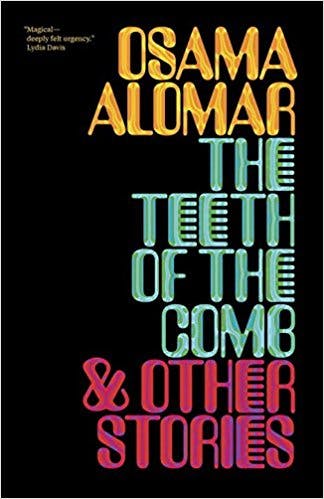“In the first six months of the revolution, I was so optimistic,” Osama Alomar, a Damascus-born writer, has said of the civil war in his home country. “It was a real revolution against a tyrant regime. Then it became something else. ... The whole world is fighting inside Syria and it looks like hell.” Alomar, who moved to Chicago in 2008, at 40, missed the onset of the war by just three years. His new book, The Teeth of the Comb, is only his second in English, but before he emigrated he had been widely published in Arabic newspapers and magazines; his four books were printed in Lebanon to avoid the Assad government’s censors. After his self-imposed exile, things were harder. In the U.S., he worked as a cab driver, and would scribble his fiction in the driver’s seat between fares. Maybe this is why his stories are so short—some are no longer than a sentence. The Teeth of the Comb, a slim volume, contains more than 150.

There is precedent for Arabic microfiction. The al-qissa al-qasira jiddan, or very short story, has deep roots in the Arabic literary tradition. It stretches from the hundreds-of-years-old One Thousand and One Nights to Khalil Gibran at the beginning of the 20th century to more contemporary practitioners like Egyptian Nobel Prize winner Naguib Mahfouz. In Syria, tightly wound fictional bits gained newfound prominence in the 1990s, according to Alomar’s translator CJ Collins, as a reaction to the government’s tightening grip on free expression. Alomar wasn’t the only writer who had to have his work published abroad. Meanwhile, very short stories have also grown in popularity in the United States, with MFA programs offering classes on the form and an increasing number of online literary journals looking to publish brief, shareable pieces. Alomar fits into both of these traditions: His work speaks to the power that words can have when they’re constrained, be it by style or by necessity. When his writing caught on with American readers, he was hailed as a master of the form.
By the time his English-language debut, Fullblood Arabian, was published in 2014, Alomar had earned endorsements from two of the United States’ most prominent practitioners of very short fiction, Diane Williams and Lydia Davis (he shares an agent with the latter). Williams published some of Alomar’s work in her literary journal, NOON, and Davis wrote an insightful and laudatory introduction to his first book. While his work has much in common with that pair, many of Alomar’s shortest pieces are closer to something one might find in Sarah Manguso’s addictive 300 Arguments; they’re straightforward, and generally there is no plot. Some of the pieces read like poems; some like parables, some like punch lines.
The stories in The Teeth of the Comb, translated with Collins, vary in length from single sentences to a few pages, and over the course of the book Alomar covers a great deal of subjects with graceful precision. As he told Sampsonia Way, “[the] form looks like a bullet. It’s very fast. It gives you my idea, and that is it.”
Many of the stories are about power, and the violence, both implicit and explicit, imbued in its existence. The entirety of “Ants” reads “When I crushed a large number of ants by accident with my feet, I realized that weakness is punishment without wrongdoing.” It has that special quality that give allegories their power: It seems obvious, but only after you finish it. Many of the stories use animals or household objects as a window into the human. Later, in “Greatest Creatures,” a mother ant and a son ant are discussing which species is better, humans or ants. The story ends when the mother points out that, though humans have many geniuses among them, they’ve been unable to prevent the catastrophic from occurring, and the fact that ants have prevented it makes them better. Like Alomar’s best work, it makes a point that is equal parts silly and compelling: By most metrics, humans seem a great deal more important than ants, but it also seems obvious that whichever species finds a way to avoid destroying itself is the better one.
In “Who Deserves a Muzzle?” a dog watches his owners shout at one another and considers whether it makes sense that he be required to wear a muzzle and collar when his behavior is so much better than theirs. Later, in “They Don’t Know How to Bark,” two dogs reflect with sympathy and pity on human’s poor sense of smell and ugly language. Again, Alomar is being fundamentally ridiculous while making an odd sort of sense: He’s writing against the arrogance that can come from a limited perspective. But these are not children’s fables: Alomar often centers greed, arrogance, cruelty, and above all, folly. When inanimate objects attempt to replicate what they see from humans as a means of self-determination, it has disastrous consequences, like in the collection’s title story:
“Some of the teeth of the comb were envious of human class differences. They strived to increase their height, and, when they succeeded, began to look with disdain on their colleagues below. After a little while, the comb’s owner felt a desire to comb his hair. But when he found it in this state, he threw it in the garbage. “
In Alomar’s world, human behavior seems destructive, even to people, as long as they’re not the ones they’re observing. The change in perspective is what reveals human beings as ridiculous: If it is ridiculous for a comb to be vain, how ridiculous is it for a person?
Throughout the stories, humanity is often portrayed as the enemy of everything within its striking distance. But the harm is often inflicted in the background, like it’s just something that happens. When Alomar turns his attention to the elements that make that harm possible, things begin to feel much less silly. In “A Taste,” the devil tastes a drop of human hatred, is poisoned, and dies. Alomar hits this note again in “Human Malice,” where an argument between a nuclear bomb and a grenade over which is more evil is ended when human malice intervenes and points out that it created them both. Alomar posits hatred and malice as elements of human nature, not its sum total, but in emphasizing their destructive powers, he recognizes their control over the way huge swaths of the world lives. The effect is that Alomar’s stories give brief flashes of insight into the magnitude of human evil, like staring directly into the sun for a moment before having to look away.
It’s not that Alomar is cynical; he’s exhausted. “Journey of Life,” the first story in The Teeth of the Comb, follows a nameless, sexless character as they pour over maps and walk through crowds shouting for a “beloved” they never find. The true object of the search is only revealed in the last line: “I stood on my shaking legs and continued my journey, searching for humanity until the last moment.” The character maintains hope because they are willing to continue searching, but the reader can see the truth: they’ll be looking forever. Importantly, Alomar does not denigrate his character for their wrongheadedness; instead, he casts the quest as noble, in spite of its futility.
Alomar may have a vested interest in hope beyond hope, as he himself has lost much that he can’t get back. In 2014, a bomb leveled an apartment he owned in Syria, destroying his library and many of his unpublished manuscripts, including a novel. Nevertheless, he refuses to pin a hopeful coda to the end of The Teeth of the Comb, which would have given a more comforting but less honest conclusion. Instead, the hope that exists in these stories exists alongside the cruelty, despair, and foolishness. Their uneasy balance is what gives Alomar’s work its disquieting power.
So much of The Teeth of the Comb feels like a writer finding a way to honestly express fear and sadness, but Alomar also finds room for more uplifting moments. In “Homeless Buildings,” a civil war in an unnamed country has made buildings feel lonely, so they move closer together, to comfort one another. Once the war ends, the buildings maintain their connection, “and because of this, human relationships became far warmer and closer than they had ever been before.” The humans in “Homeless Buildings” do not grow more affectionate and caring because they would inevitably do so, but because the environment around them changed. It doesn’t argue that the forces in “A Taste” or “Human Malice” don’t exist, but that they are not guaranteed victory. The potential for a better world exists, even if it takes a supernatural change to get there.
Many of the stories in The Teeth of the Comb were written before the Syrian war, some before Alomar had even left Syria, and there is no indication in the book which stories were written when. It’s a testament to his talent that despite the world having drastically shifted underneath his stories, they still ring true. In Collins’ translator’s note at the end of Fullblood Arabian, he described sitting in the front seat of Alomar’s cab as the writer shuttled passengers between O’Hare International airport and the Chicago suburbs, collaborating on translations of his stories between passengers. The process was no different for The Teeth of the Comb: It took a herculean effort to make the books possible. With that in mind, Alomar seems like a contradiction of much of his own work—marked, as the final products are, by simplicity and brevity. The exception might be in the collection’s final story. A stream shouts at a school of upstream-swimming salmon, telling them to give up, and that their determination will be for nothing. “But the fish answered him in one voice, ‘We won’t surrender!’”
